Principles of Valuation Report: Spencer's, IVSC, and Land Valuation
VerifiedAdded on 2020/05/04
|7
|1611
|118
Report
AI Summary
This report delves into the principles of valuation, emphasizing the importance of determining market value and the highest and best use of land. It begins by outlining the necessary steps a valuer must take when accepting an assignment, stressing integrity and competence. The report then contrasts the Spencer's and IVSC definitions of market value, highlighting their similarities and differences, particularly in how they address assets and the concept of highest and best use. The discussion extends to the inherent and external features of land, illustrating how factors like size, topography, amenities, and surrounding environment influence property value. The concept of highest and best use is explored as a key appraisal principle, emphasizing its role in determining a property's present value and its potential for generating the greatest net return. Finally, the report underscores the significance of supply and demand, and the roles of both buyers and sellers in establishing market value. This analysis provides a comprehensive overview of the critical factors involved in land and property valuation, offering valuable insights for understanding how land values are determined.

Running head: PRINCIPLES OF VALUATION
Principles of valuation
Name
Institution
Date of submission
Principles of valuation
Name
Institution
Date of submission
Paraphrase This Document
Need a fresh take? Get an instant paraphrase of this document with our AI Paraphraser
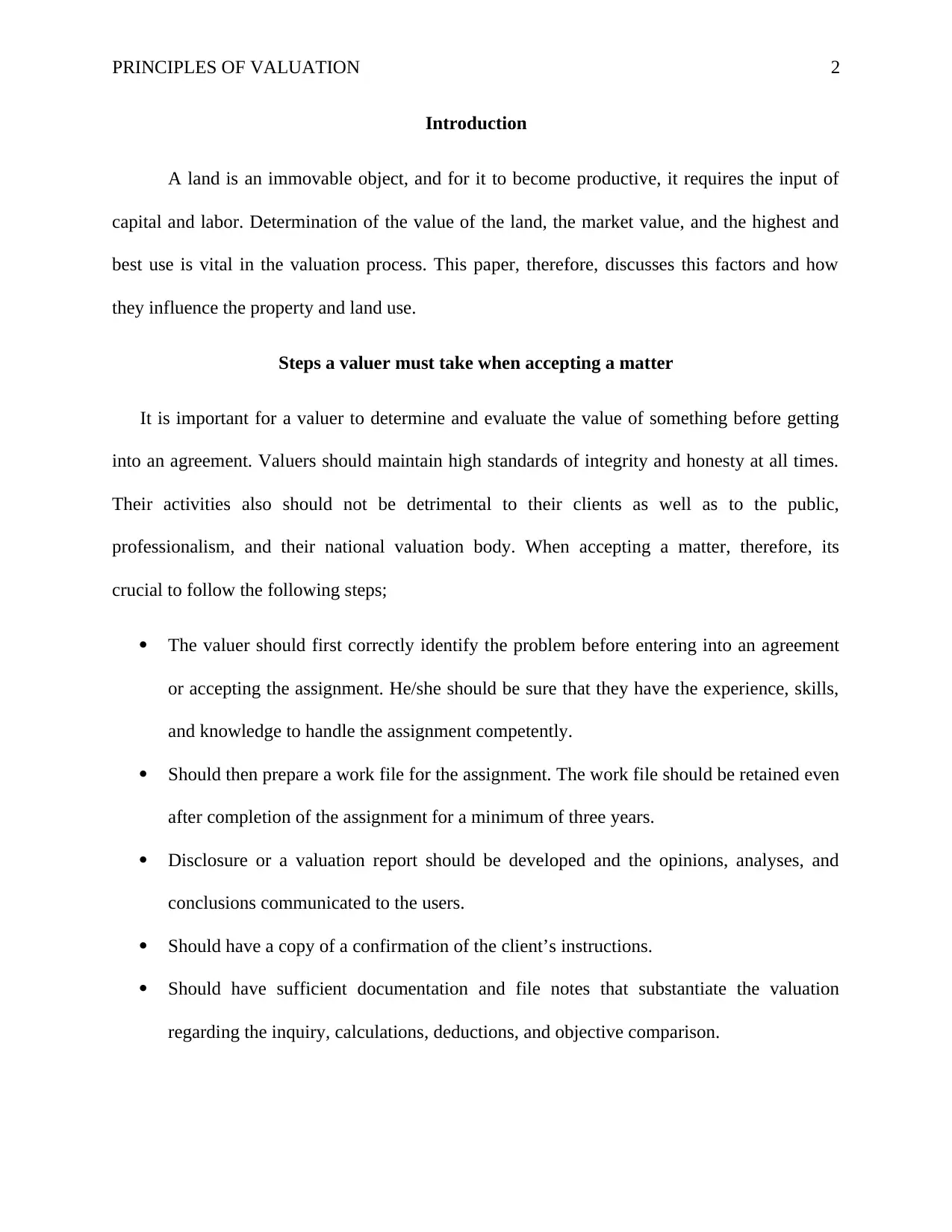
PRINCIPLES OF VALUATION 2
Introduction
A land is an immovable object, and for it to become productive, it requires the input of
capital and labor. Determination of the value of the land, the market value, and the highest and
best use is vital in the valuation process. This paper, therefore, discusses this factors and how
they influence the property and land use.
Steps a valuer must take when accepting a matter
It is important for a valuer to determine and evaluate the value of something before getting
into an agreement. Valuers should maintain high standards of integrity and honesty at all times.
Their activities also should not be detrimental to their clients as well as to the public,
professionalism, and their national valuation body. When accepting a matter, therefore, its
crucial to follow the following steps;
The valuer should first correctly identify the problem before entering into an agreement
or accepting the assignment. He/she should be sure that they have the experience, skills,
and knowledge to handle the assignment competently.
Should then prepare a work file for the assignment. The work file should be retained even
after completion of the assignment for a minimum of three years.
Disclosure or a valuation report should be developed and the opinions, analyses, and
conclusions communicated to the users.
Should have a copy of a confirmation of the client’s instructions.
Should have sufficient documentation and file notes that substantiate the valuation
regarding the inquiry, calculations, deductions, and objective comparison.
Introduction
A land is an immovable object, and for it to become productive, it requires the input of
capital and labor. Determination of the value of the land, the market value, and the highest and
best use is vital in the valuation process. This paper, therefore, discusses this factors and how
they influence the property and land use.
Steps a valuer must take when accepting a matter
It is important for a valuer to determine and evaluate the value of something before getting
into an agreement. Valuers should maintain high standards of integrity and honesty at all times.
Their activities also should not be detrimental to their clients as well as to the public,
professionalism, and their national valuation body. When accepting a matter, therefore, its
crucial to follow the following steps;
The valuer should first correctly identify the problem before entering into an agreement
or accepting the assignment. He/she should be sure that they have the experience, skills,
and knowledge to handle the assignment competently.
Should then prepare a work file for the assignment. The work file should be retained even
after completion of the assignment for a minimum of three years.
Disclosure or a valuation report should be developed and the opinions, analyses, and
conclusions communicated to the users.
Should have a copy of a confirmation of the client’s instructions.
Should have sufficient documentation and file notes that substantiate the valuation
regarding the inquiry, calculations, deductions, and objective comparison.
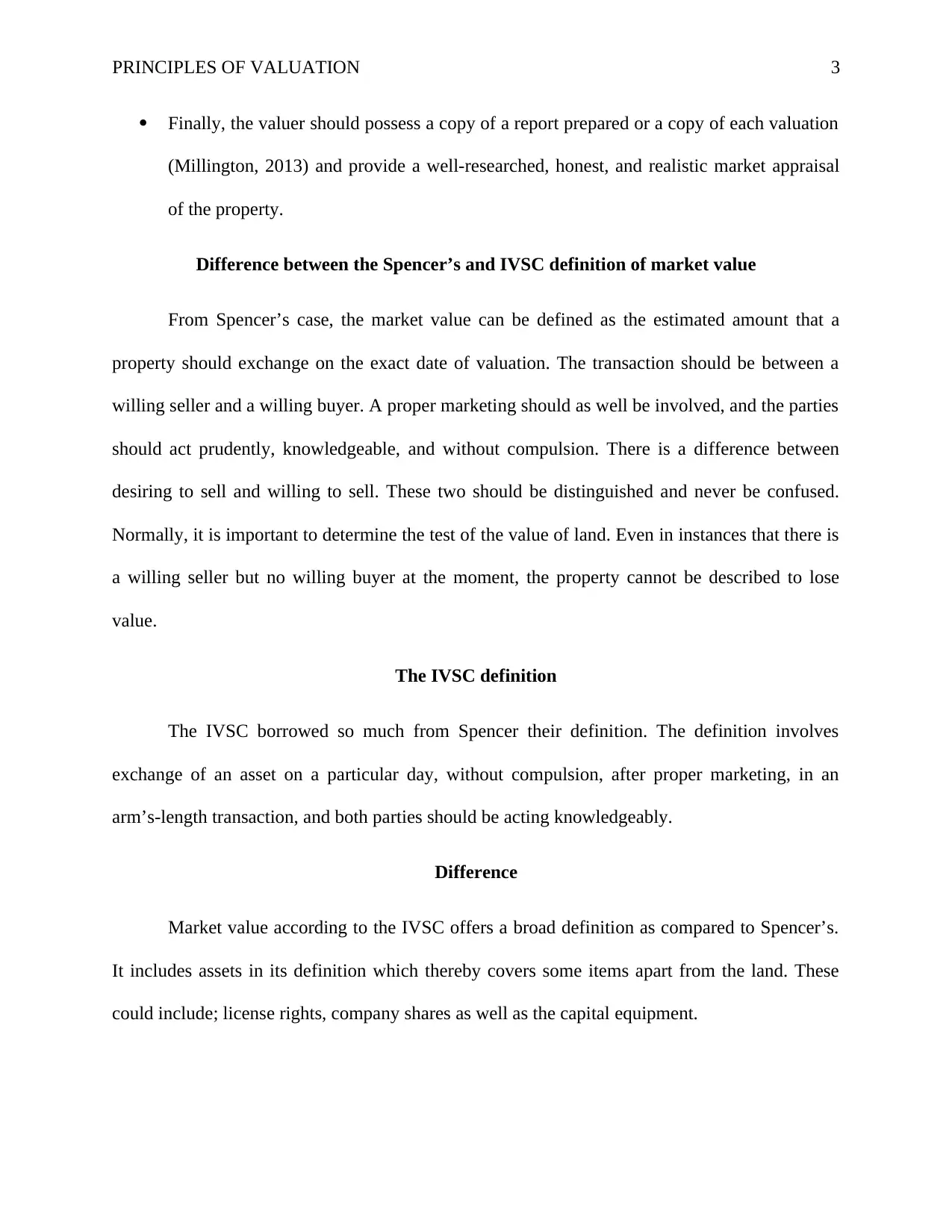
PRINCIPLES OF VALUATION 3
Finally, the valuer should possess a copy of a report prepared or a copy of each valuation
(Millington, 2013) and provide a well-researched, honest, and realistic market appraisal
of the property.
Difference between the Spencer’s and IVSC definition of market value
From Spencer’s case, the market value can be defined as the estimated amount that a
property should exchange on the exact date of valuation. The transaction should be between a
willing seller and a willing buyer. A proper marketing should as well be involved, and the parties
should act prudently, knowledgeable, and without compulsion. There is a difference between
desiring to sell and willing to sell. These two should be distinguished and never be confused.
Normally, it is important to determine the test of the value of land. Even in instances that there is
a willing seller but no willing buyer at the moment, the property cannot be described to lose
value.
The IVSC definition
The IVSC borrowed so much from Spencer their definition. The definition involves
exchange of an asset on a particular day, without compulsion, after proper marketing, in an
arm’s-length transaction, and both parties should be acting knowledgeably.
Difference
Market value according to the IVSC offers a broad definition as compared to Spencer’s.
It includes assets in its definition which thereby covers some items apart from the land. These
could include; license rights, company shares as well as the capital equipment.
Finally, the valuer should possess a copy of a report prepared or a copy of each valuation
(Millington, 2013) and provide a well-researched, honest, and realistic market appraisal
of the property.
Difference between the Spencer’s and IVSC definition of market value
From Spencer’s case, the market value can be defined as the estimated amount that a
property should exchange on the exact date of valuation. The transaction should be between a
willing seller and a willing buyer. A proper marketing should as well be involved, and the parties
should act prudently, knowledgeable, and without compulsion. There is a difference between
desiring to sell and willing to sell. These two should be distinguished and never be confused.
Normally, it is important to determine the test of the value of land. Even in instances that there is
a willing seller but no willing buyer at the moment, the property cannot be described to lose
value.
The IVSC definition
The IVSC borrowed so much from Spencer their definition. The definition involves
exchange of an asset on a particular day, without compulsion, after proper marketing, in an
arm’s-length transaction, and both parties should be acting knowledgeably.
Difference
Market value according to the IVSC offers a broad definition as compared to Spencer’s.
It includes assets in its definition which thereby covers some items apart from the land. These
could include; license rights, company shares as well as the capital equipment.
⊘ This is a preview!⊘
Do you want full access?
Subscribe today to unlock all pages.

Trusted by 1+ million students worldwide
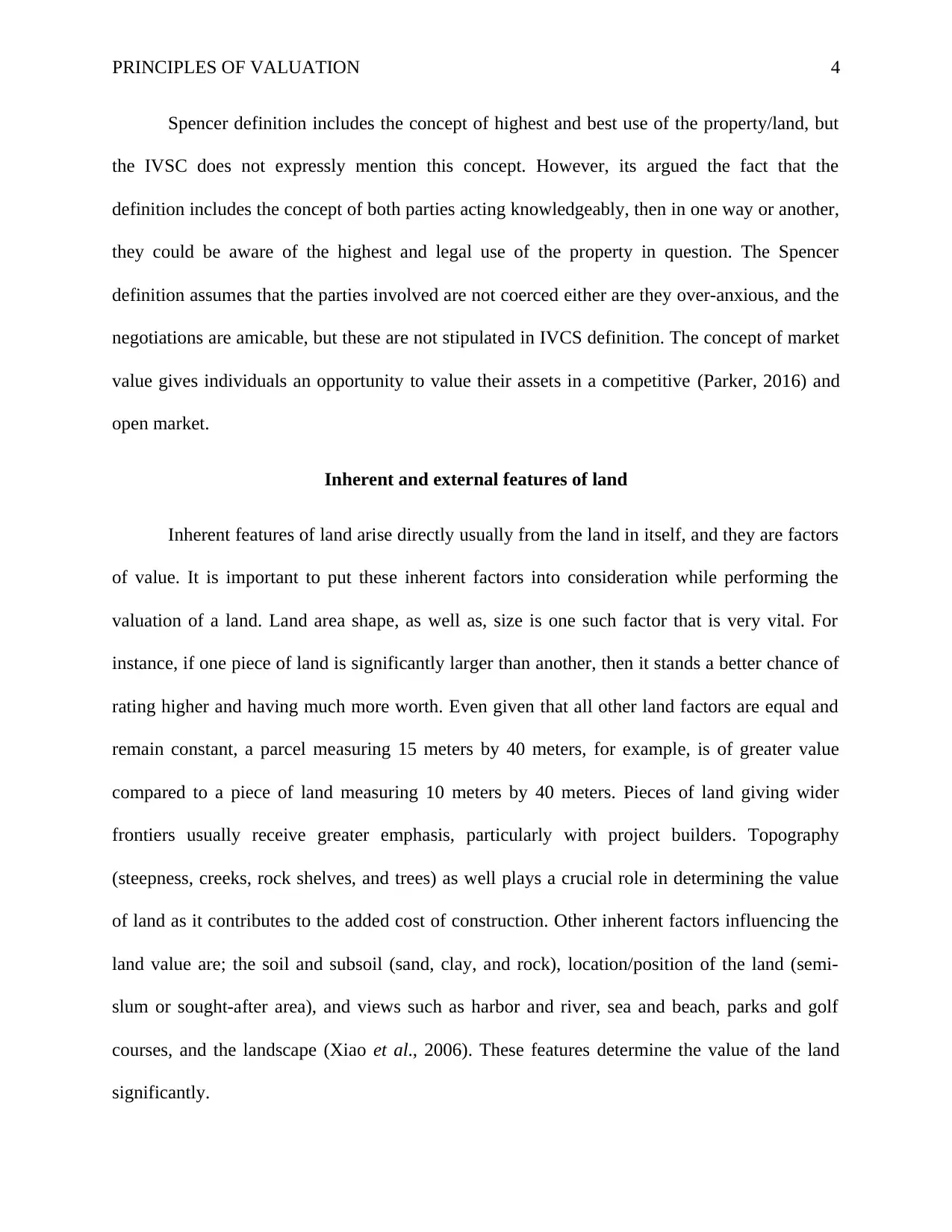
PRINCIPLES OF VALUATION 4
Spencer definition includes the concept of highest and best use of the property/land, but
the IVSC does not expressly mention this concept. However, its argued the fact that the
definition includes the concept of both parties acting knowledgeably, then in one way or another,
they could be aware of the highest and legal use of the property in question. The Spencer
definition assumes that the parties involved are not coerced either are they over-anxious, and the
negotiations are amicable, but these are not stipulated in IVCS definition. The concept of market
value gives individuals an opportunity to value their assets in a competitive (Parker, 2016) and
open market.
Inherent and external features of land
Inherent features of land arise directly usually from the land in itself, and they are factors
of value. It is important to put these inherent factors into consideration while performing the
valuation of a land. Land area shape, as well as, size is one such factor that is very vital. For
instance, if one piece of land is significantly larger than another, then it stands a better chance of
rating higher and having much more worth. Even given that all other land factors are equal and
remain constant, a parcel measuring 15 meters by 40 meters, for example, is of greater value
compared to a piece of land measuring 10 meters by 40 meters. Pieces of land giving wider
frontiers usually receive greater emphasis, particularly with project builders. Topography
(steepness, creeks, rock shelves, and trees) as well plays a crucial role in determining the value
of land as it contributes to the added cost of construction. Other inherent factors influencing the
land value are; the soil and subsoil (sand, clay, and rock), location/position of the land (semi-
slum or sought-after area), and views such as harbor and river, sea and beach, parks and golf
courses, and the landscape (Xiao et al., 2006). These features determine the value of the land
significantly.
Spencer definition includes the concept of highest and best use of the property/land, but
the IVSC does not expressly mention this concept. However, its argued the fact that the
definition includes the concept of both parties acting knowledgeably, then in one way or another,
they could be aware of the highest and legal use of the property in question. The Spencer
definition assumes that the parties involved are not coerced either are they over-anxious, and the
negotiations are amicable, but these are not stipulated in IVCS definition. The concept of market
value gives individuals an opportunity to value their assets in a competitive (Parker, 2016) and
open market.
Inherent and external features of land
Inherent features of land arise directly usually from the land in itself, and they are factors
of value. It is important to put these inherent factors into consideration while performing the
valuation of a land. Land area shape, as well as, size is one such factor that is very vital. For
instance, if one piece of land is significantly larger than another, then it stands a better chance of
rating higher and having much more worth. Even given that all other land factors are equal and
remain constant, a parcel measuring 15 meters by 40 meters, for example, is of greater value
compared to a piece of land measuring 10 meters by 40 meters. Pieces of land giving wider
frontiers usually receive greater emphasis, particularly with project builders. Topography
(steepness, creeks, rock shelves, and trees) as well plays a crucial role in determining the value
of land as it contributes to the added cost of construction. Other inherent factors influencing the
land value are; the soil and subsoil (sand, clay, and rock), location/position of the land (semi-
slum or sought-after area), and views such as harbor and river, sea and beach, parks and golf
courses, and the landscape (Xiao et al., 2006). These features determine the value of the land
significantly.
Paraphrase This Document
Need a fresh take? Get an instant paraphrase of this document with our AI Paraphraser
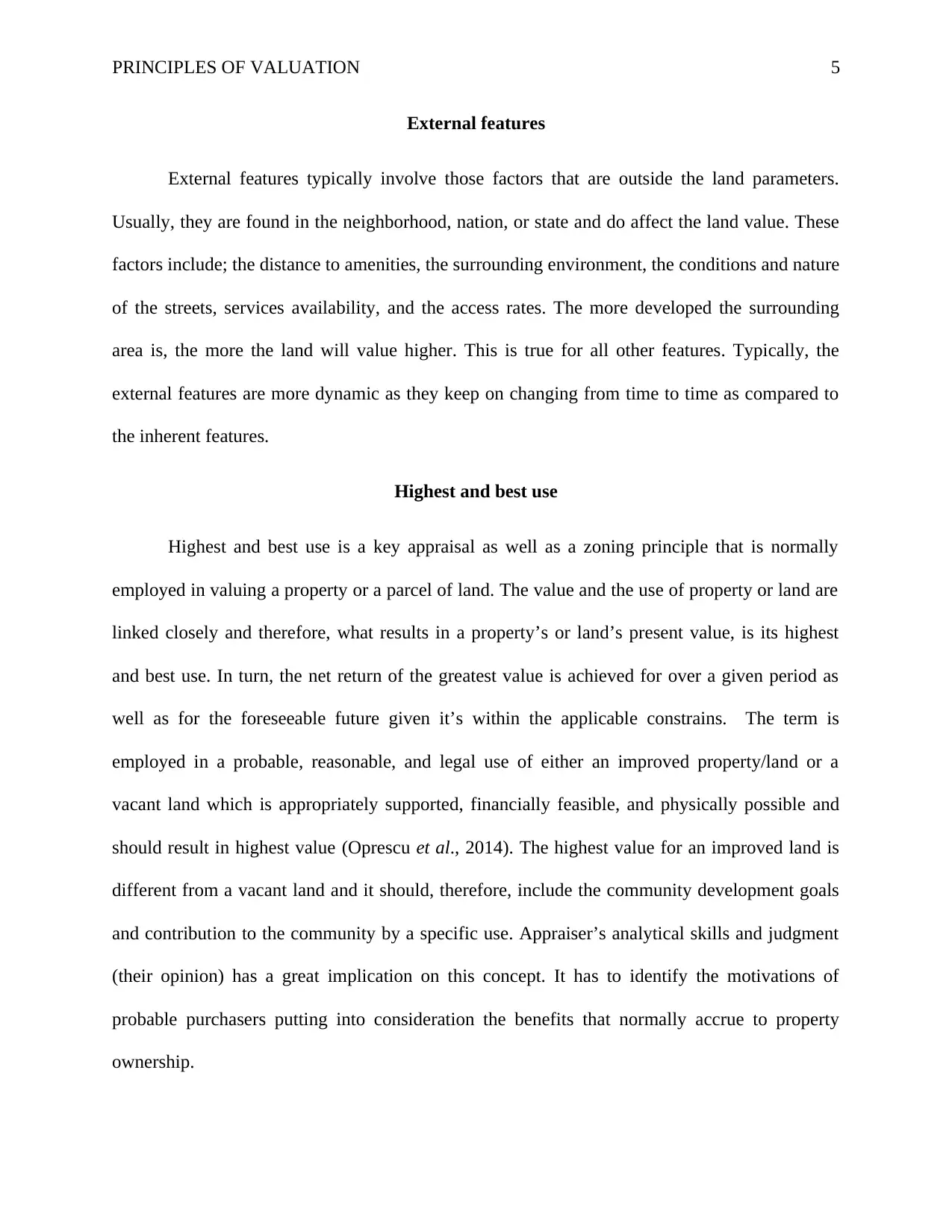
PRINCIPLES OF VALUATION 5
External features
External features typically involve those factors that are outside the land parameters.
Usually, they are found in the neighborhood, nation, or state and do affect the land value. These
factors include; the distance to amenities, the surrounding environment, the conditions and nature
of the streets, services availability, and the access rates. The more developed the surrounding
area is, the more the land will value higher. This is true for all other features. Typically, the
external features are more dynamic as they keep on changing from time to time as compared to
the inherent features.
Highest and best use
Highest and best use is a key appraisal as well as a zoning principle that is normally
employed in valuing a property or a parcel of land. The value and the use of property or land are
linked closely and therefore, what results in a property’s or land’s present value, is its highest
and best use. In turn, the net return of the greatest value is achieved for over a given period as
well as for the foreseeable future given it’s within the applicable constrains. The term is
employed in a probable, reasonable, and legal use of either an improved property/land or a
vacant land which is appropriately supported, financially feasible, and physically possible and
should result in highest value (Oprescu et al., 2014). The highest value for an improved land is
different from a vacant land and it should, therefore, include the community development goals
and contribution to the community by a specific use. Appraiser’s analytical skills and judgment
(their opinion) has a great implication on this concept. It has to identify the motivations of
probable purchasers putting into consideration the benefits that normally accrue to property
ownership.
External features
External features typically involve those factors that are outside the land parameters.
Usually, they are found in the neighborhood, nation, or state and do affect the land value. These
factors include; the distance to amenities, the surrounding environment, the conditions and nature
of the streets, services availability, and the access rates. The more developed the surrounding
area is, the more the land will value higher. This is true for all other features. Typically, the
external features are more dynamic as they keep on changing from time to time as compared to
the inherent features.
Highest and best use
Highest and best use is a key appraisal as well as a zoning principle that is normally
employed in valuing a property or a parcel of land. The value and the use of property or land are
linked closely and therefore, what results in a property’s or land’s present value, is its highest
and best use. In turn, the net return of the greatest value is achieved for over a given period as
well as for the foreseeable future given it’s within the applicable constrains. The term is
employed in a probable, reasonable, and legal use of either an improved property/land or a
vacant land which is appropriately supported, financially feasible, and physically possible and
should result in highest value (Oprescu et al., 2014). The highest value for an improved land is
different from a vacant land and it should, therefore, include the community development goals
and contribution to the community by a specific use. Appraiser’s analytical skills and judgment
(their opinion) has a great implication on this concept. It has to identify the motivations of
probable purchasers putting into consideration the benefits that normally accrue to property
ownership.

PRINCIPLES OF VALUATION 6
The market value of a land is primarily established through the laws of supply and
demand. Both price expectations of a buyer and a seller are crucial in determining the value of a
parcel of land or any other property. Both the buyer and the seller play a vital role in the
subjective concept of market value. It becomes critical, therefore, for purchasers to analyze the
most profitable use of the land either in a vacant state or an improved state. It is also important to
understand that the highest and best use of a land or any other property for that matter, can be as
a result of a class of uses rather than for a specific use.
Conclusion
Valuation of a land is important in determining the annual returns. Determination of the
market value as well as a significant role to play in the whole concept of the principles of land
and property valuation. Its, therefore, important to understand all these variables and how they
affect the highest value of the land.
The market value of a land is primarily established through the laws of supply and
demand. Both price expectations of a buyer and a seller are crucial in determining the value of a
parcel of land or any other property. Both the buyer and the seller play a vital role in the
subjective concept of market value. It becomes critical, therefore, for purchasers to analyze the
most profitable use of the land either in a vacant state or an improved state. It is also important to
understand that the highest and best use of a land or any other property for that matter, can be as
a result of a class of uses rather than for a specific use.
Conclusion
Valuation of a land is important in determining the annual returns. Determination of the
market value as well as a significant role to play in the whole concept of the principles of land
and property valuation. Its, therefore, important to understand all these variables and how they
affect the highest value of the land.
⊘ This is a preview!⊘
Do you want full access?
Subscribe today to unlock all pages.

Trusted by 1+ million students worldwide
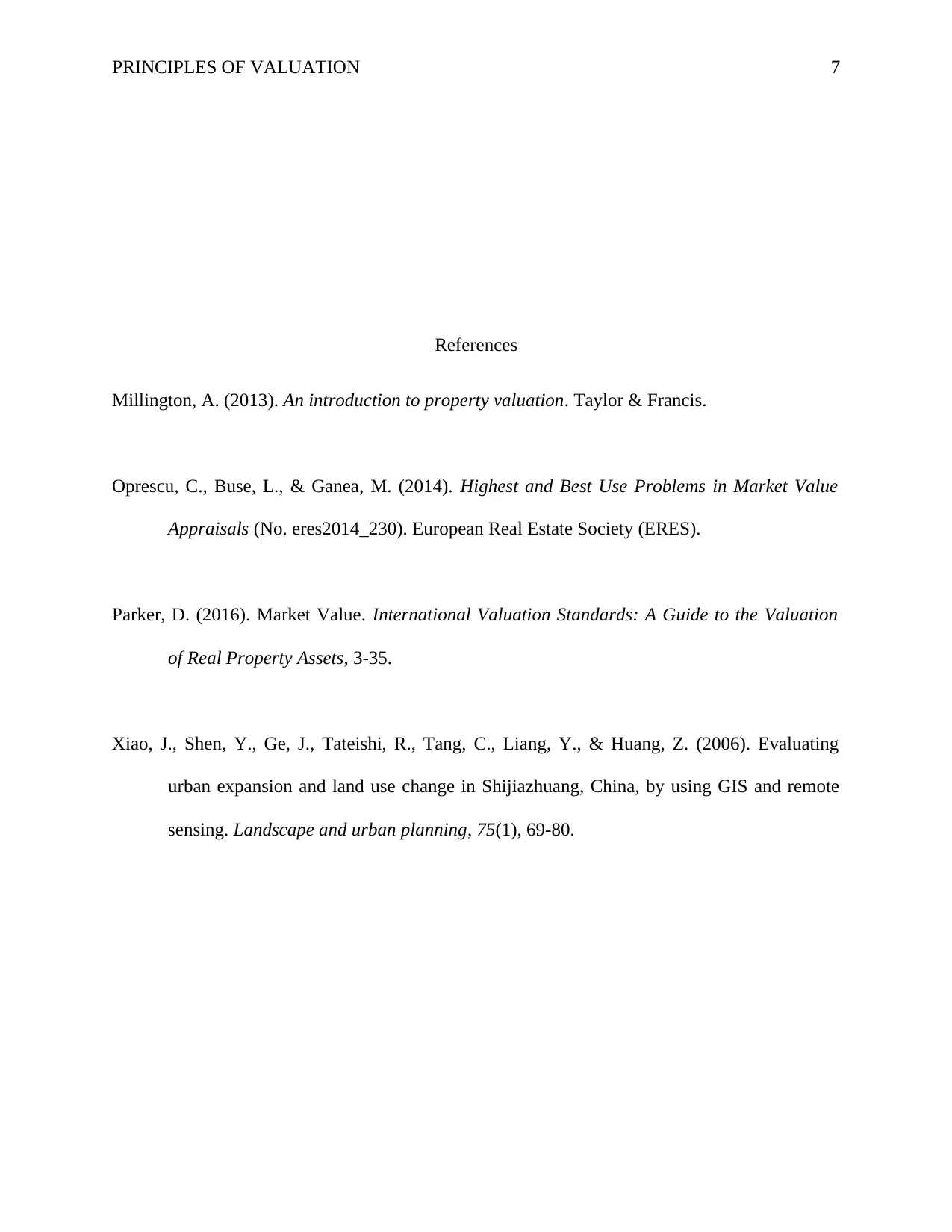
PRINCIPLES OF VALUATION 7
References
Millington, A. (2013). An introduction to property valuation. Taylor & Francis.
Oprescu, C., Buse, L., & Ganea, M. (2014). Highest and Best Use Problems in Market Value
Appraisals (No. eres2014_230). European Real Estate Society (ERES).
Parker, D. (2016). Market Value. International Valuation Standards: A Guide to the Valuation
of Real Property Assets, 3-35.
Xiao, J., Shen, Y., Ge, J., Tateishi, R., Tang, C., Liang, Y., & Huang, Z. (2006). Evaluating
urban expansion and land use change in Shijiazhuang, China, by using GIS and remote
sensing. Landscape and urban planning, 75(1), 69-80.
References
Millington, A. (2013). An introduction to property valuation. Taylor & Francis.
Oprescu, C., Buse, L., & Ganea, M. (2014). Highest and Best Use Problems in Market Value
Appraisals (No. eres2014_230). European Real Estate Society (ERES).
Parker, D. (2016). Market Value. International Valuation Standards: A Guide to the Valuation
of Real Property Assets, 3-35.
Xiao, J., Shen, Y., Ge, J., Tateishi, R., Tang, C., Liang, Y., & Huang, Z. (2006). Evaluating
urban expansion and land use change in Shijiazhuang, China, by using GIS and remote
sensing. Landscape and urban planning, 75(1), 69-80.
1 out of 7
Related Documents
Your All-in-One AI-Powered Toolkit for Academic Success.
+13062052269
info@desklib.com
Available 24*7 on WhatsApp / Email
![[object Object]](/_next/static/media/star-bottom.7253800d.svg)
Unlock your academic potential
Copyright © 2020–2025 A2Z Services. All Rights Reserved. Developed and managed by ZUCOL.





